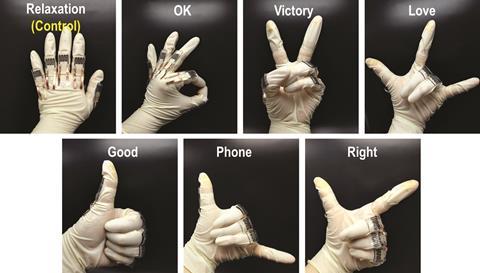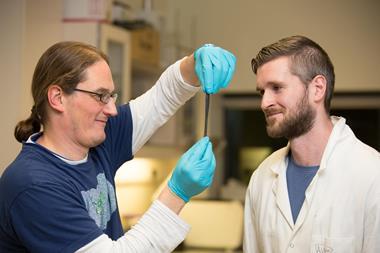Printed aerogel’s translation of sign language speaks volumes for 3D graphene materials

Scientists in China have printed conductive 3D graphene structures and applied them in a wearable electronic device that can translate common sign language gestures into written text. Given the simplicity underpinning its manufacture, during which graphene ink is extruded from a syringe, this material could inject some pace into the printed electronics field.
Wearable and bio-integrated devices are mainstays in medical technology, ranging from adhesive patches that measure heart and respiratory rate to brain–computer interfaces that induce neural activity. Its remarkable mechanical and electrical properties cast graphene, a 2D honeycomb lattice of carbon atoms, as a key future player in the wearable technology arena. However, it is a challenge to preserve the advantages of graphene’s sheet-like nanostructure in a 3D material that – unlike typical 2D materials – can relay information about forces from every angle.
Yanlin Song and co-workers at the University of the Chinese Academy of Sciences, Beijing, and Shenyang Jianzhu University, Shenyang, have recently developed a 3D graphene material with air-filled voids that allow it to be compressed and stretched in all directions.
The aerogel’s conductivity varies with physical deformation, letting it relay subtle body movements with electrical cues. Once the researchers equipped it with electrodes and packaged it in poly(dimethylsiloxane), the graphene material could be used to make a wearable device programmed to recognise hand gestures and turn them into written and spoken words.
According to Fengyu Li, one of the researchers working with Song, the aerogel is made using ‘quite traditional printing technology’, involving the simple extrusion of oxidised graphene ink from a syringe. Vacuum freeze-drying then removes the liquid component of the ink, and chemical reduction with hydroiodic acid improves the resulting aerogel’s electrical conductivity.
‘Printing, I think, is the most effective technique for creating surface patterns for materials to tailor their functional properties,’ says Li. ‘We are also currently using it with silver nanoparticles and quantum dots to create electronic devices.’
‘It is exciting to witness the rapid innovation in this dynamic field,’ comments Marcus Worsley from Lawrence Livermore National Laboratory, US, who also works on aerogels made of carbon nanomaterials. ‘The success of this research in applying printed graphene aerogels to wearable flexible electronics is a big step forward in demonstrating their great potential.’
References
This article is free to access until 06 October 2016
B An et al, Chem. Commun., 2016, DOI: 10.1039/C6CC05910D












No comments yet